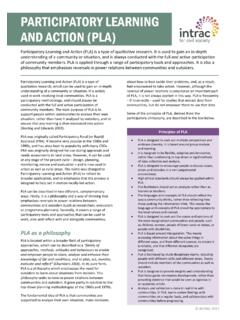Transcription of Participatory Action Research Toolkit
1 Participatory ActionResearch Toolkit :An Introduction to Using PAR as an Approachto Learning , Research and ActionParticipatory ActionResearch Toolkit :An Introduction to Using PAR as an Approachto Learning , Research and ActionRachel Pain, Geo Whitman andDavid Milledge (Durham University)& Lune Rivers Trust2 Participatory Action Research Toolkit : An Introduction to Using PAR as an Approach to Learning , Research and Action Participatory Action Researchis collaborative Research , education and Action used to gather information to use for change on social or environmental issues.
2 It involves people who are concerned about or affected by an issue taking a leading role in producing and using knowledge about it. Many names are now used to describe Research processes that are in some way Participatory : Participatory Appraisal, Participatory Learning and Action , community - based Participatory Research . PAR is distinct because: it is driven by participants (a group of people who have a stake in the environmental issue being researched), rather than an outside sponsor, funder or academic (although they may be invited to help), it offers a democratic model of who can produce, own and use knowledge, it is collaborative at every stage, involving discussion, pooling skills and working together, it is intended to result in some Action , change or improvement on the issue being researched.
3 What this Toolkit offersThis Toolkit is intended to provide guidance on what a PAR project commonly looks like, how to work together and some questions to ask as you go. It does not provide advice on methods, as these will vary depending on what the Research is about. There are many sources available for methods to use within a PAR Research would you use PAR?If you want to gather and use information so that benefits come to the people it directly affects. PAR is used by a whole range of community groups and organisations (where people already know each other and/or work together), and also by groups that come together for the purposes of Research and Action on a particular PAR a method or an approach?
4 PAR is an approach to Research . It is a set of principles and practices for originating, designing, conducting, analysing and acting on a piece of Research . PAR is not a method. Within PAR projects, many different methods may be used group discussion, interviews, diagramming, video, photography, art, surveys, mapping, the collection of environmental data, computer analysis of datasets, etc. An example:A PAR project that involved a collaboration between the Lune River Trust and human and physical geographers from Durham University is described in detail elsewhere.
5 This project gave rise to this Toolkit , and provides some illustration of the issues that follow. The team included members of the Lune Rivers Trust (LRT) in Lancashire, and three members of Durham University team who had expertise in river science, environment/ecology, and the use of PAR. We worked together over several months. Each meeting involved planning, Action and reflection. The first task was to decide on the issue that the Research would focus on. A list of issues that the LRT were currently concerned about was drawn up and discussed, until the Research was narrowed down to the problem of slurry getting into the river.
6 The river scientist on the University team gathered together some previous Research on slurry and shared this with the participants. They then defined the exact question they would like to answer, spending time discussing the potential benefits and pitfalls and how they would deal with political sensitivities around the issue. He then introduced them to SCIMAP, a computer mapping software package, as a possible aid to the Research . The LRT participants critiqued its assumptions, and came up with the idea of using it to produce a farm vulnerability model.
7 Working together, we then produced this over several weeks. The river scientist undertook modelling each week, and at meetings the group critiqued the outputs, added to them, clarified them and gave him directions for the next week. In between, using the maps produced, they undertook surveys of land use cover and building use which fed into the analysis, and stipulated what the final outputs should look like. Once the Research was complete, the whole team planned its dissemination, and then evaluated the project both as a group and as individuals.
8 This Toolkit was developed as a result of the project Building Adaptive Strategies for Environmental Change with Land Use Managers , which was funded under the ESRC Rural Economy and Land Use Programme, contact the staff involved for further information: Professor Rachel Pain, Dr Geoff Whitman and Dr David Milledge Department of Geography, Durham University, South Road, Durham, DH1 3LE, UK3An Introduction to Using PAR as an Approach to Learning , Research and Action Typical stages of a PAR projectPAR involves recurrent stages of Planning, Action and Reflection, followed by Evaluation.
9 Some typical stages of a PAR project are:Table 1: Typical key stages in PAR (adapted from Kindon et al., 2007)In this way, Research in PAR typically goes through a cycle: Planning, Action , Reflection, Evaluation. You may undertake these cycles every time you meet, or you may, for example, save the evaluation until the Action is complete. PHASE ACTIONA ction Establish relationships and common agenda with all stakeholders. Collaboratively decide on issuesRe ection On Research design, ethics, knowledges and accountabilityAction Build relationships Identify roles and responsibilities Collectively design Research processes and tools Discuss potential outcomesRe ection On Research questions, design.
10 Working relationships and information requiredAction Work together to implement Research and collect data Enable participation of all members Collaboratively analyse ndings Collaboratively plan future actionsRe ection On working together Has participation worked? What else do we need to do? Action Begin to work on feeding Research back to all participants and plan for feedback on process and ndingsRe ection Evaluate both the Action and re ection processes as a wholeAction Collectively identify future Research and impacts4 Participatory Action Research Toolkit .





